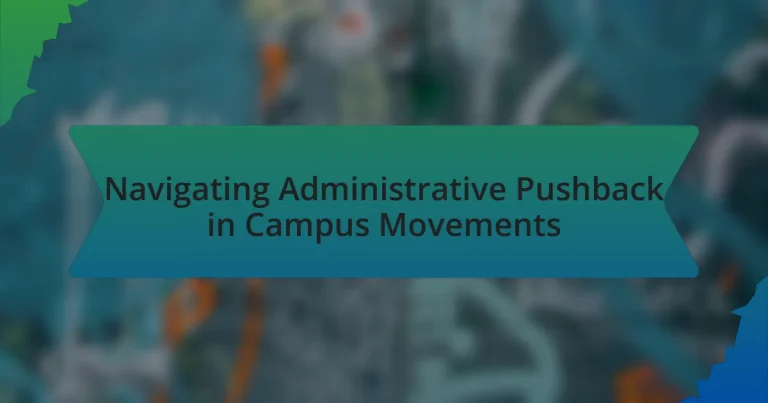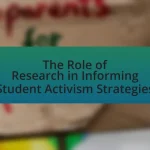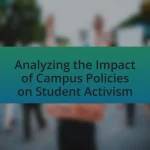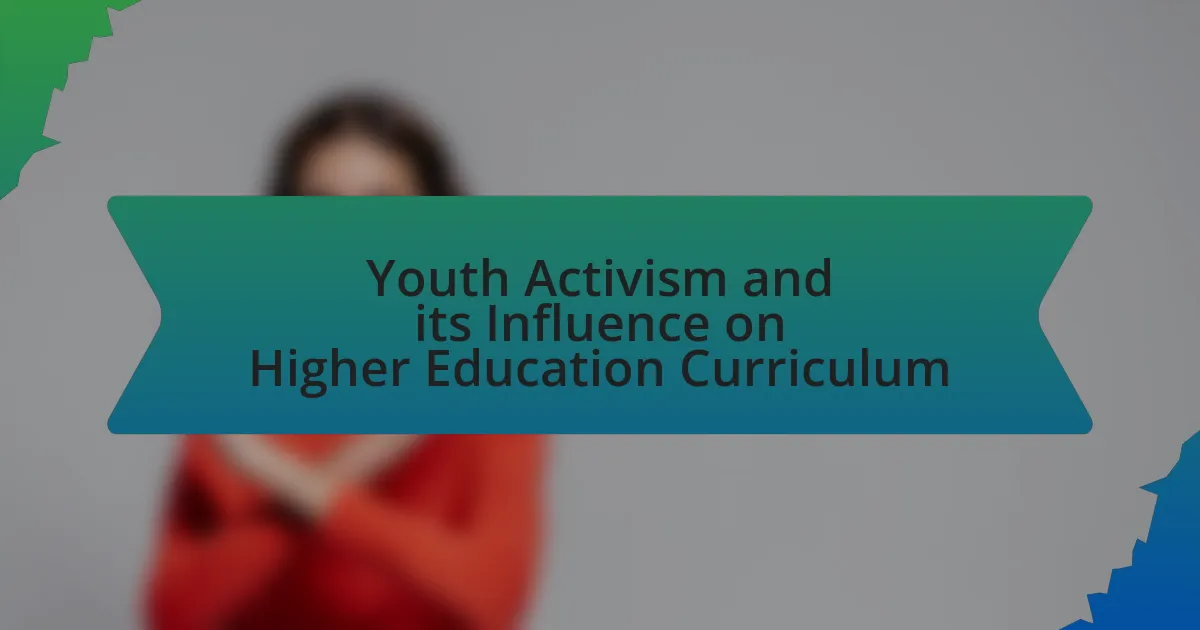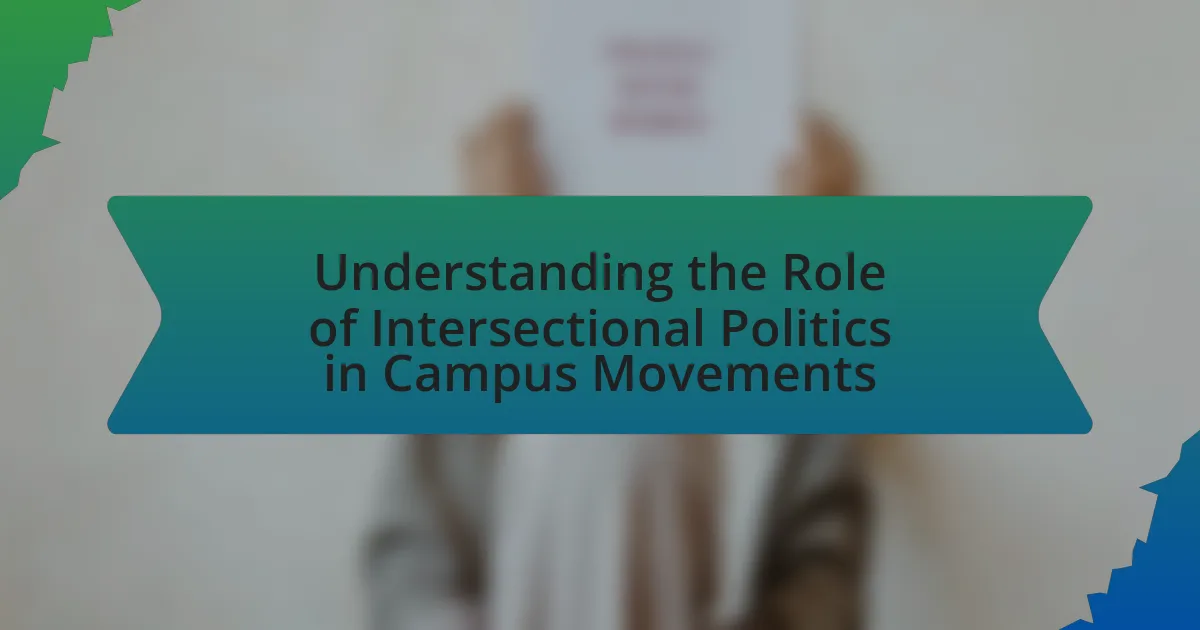Navigating administrative pushback in campus movements refers to the strategies employed by activists and student organizations to address resistance from university administrations when advocating for social change. The article explores the nature of administrative pushback, including common forms such as policy restrictions and funding denials, and emphasizes the importance of understanding this resistance for effective advocacy. It discusses historical contexts, lessons learned from past movements, and outlines strategies for successful navigation, including coalition-building and effective communication. Additionally, the article highlights the role of legal support and advocacy organizations in empowering campus movements to overcome administrative challenges.
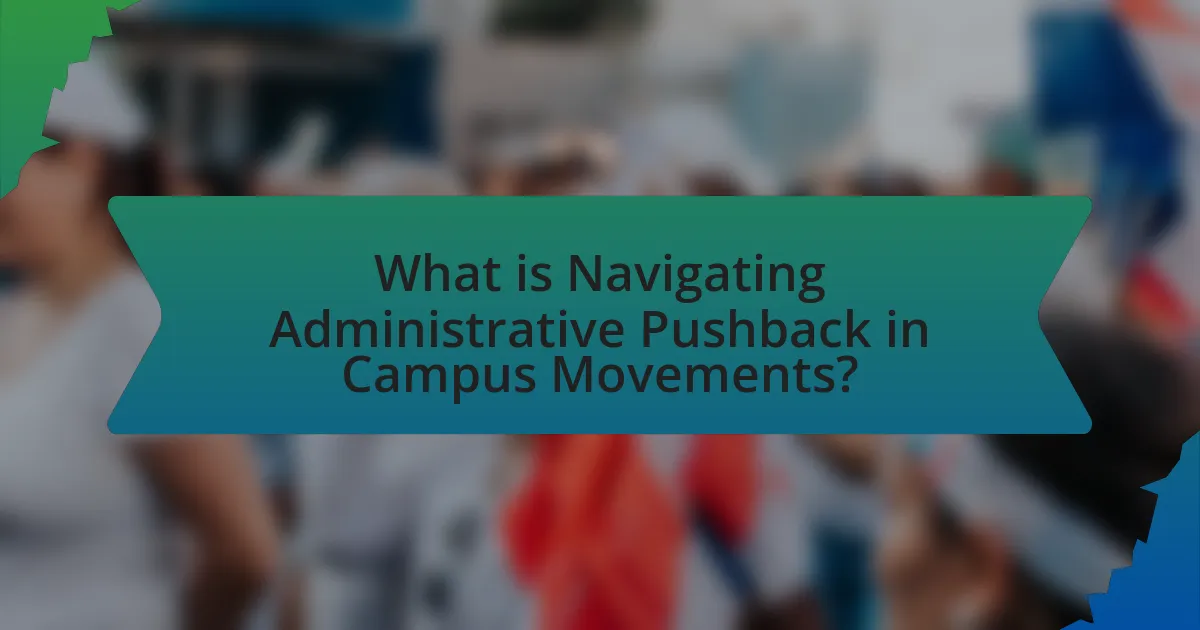
What is Navigating Administrative Pushback in Campus Movements?
Navigating administrative pushback in campus movements involves strategies that activists and student organizations employ to address resistance from university administrations when advocating for social change. This pushback can manifest as policy restrictions, lack of support, or outright opposition to student-led initiatives. Effective navigation requires understanding institutional policies, building coalitions, and employing negotiation tactics to foster dialogue and compromise. Historical examples, such as the civil rights movements on campuses in the 1960s, illustrate how students successfully confronted administrative resistance through organized protests and strategic communication, ultimately leading to significant policy changes.
Why is understanding administrative pushback important for campus movements?
Understanding administrative pushback is crucial for campus movements because it directly influences the effectiveness and sustainability of advocacy efforts. Campus movements often face resistance from administration due to differing priorities, resource allocation, or institutional policies. Recognizing the nature and sources of this pushback allows activists to strategize effectively, anticipate challenges, and adapt their approaches to foster dialogue and collaboration. For instance, a study by the American Association of University Professors highlights that successful campus movements often engage with administrative concerns, leading to more productive outcomes. Thus, understanding administrative pushback not only enhances the movement’s resilience but also increases the likelihood of achieving meaningful change.
What are the common forms of administrative pushback encountered?
Common forms of administrative pushback encountered include resistance to policy changes, denial of funding requests, and restrictions on event approvals. These forms of pushback often manifest when campus movements challenge existing norms or seek to implement new initiatives. For instance, universities may cite budget constraints to deny funding, or they may impose bureaucratic hurdles that delay or prevent the organization of events aimed at promoting social change. Such actions can hinder the effectiveness of campus movements and create an environment of frustration among advocates for change.
How does administrative pushback impact the goals of campus movements?
Administrative pushback significantly hinders the goals of campus movements by creating barriers to advocacy and limiting the effectiveness of student-led initiatives. When university administrations resist or oppose student demands, it can lead to decreased morale among activists, reduced participation in movements, and a fragmentation of collective efforts. For instance, historical examples such as the 1960s civil rights protests on campuses demonstrate that administrative resistance often resulted in prolonged struggles and necessitated alternative strategies, such as off-campus organizing, to achieve objectives. This resistance can also lead to a chilling effect, where students may feel discouraged from voicing their concerns or engaging in activism due to fear of repercussions.
What are the historical contexts of administrative pushback in campus movements?
Administrative pushback in campus movements historically arises from tensions between institutional authority and student activism. This dynamic has been evident since the 1960s, particularly during the civil rights and anti-war movements, where universities often responded to student protests with increased security measures and disciplinary actions. For instance, the Kent State shootings in 1970 exemplified the extreme measures taken by administrations to quell dissent, leading to national outrage and further mobilization of student movements. Additionally, the rise of identity-based movements in the late 20th century, such as those advocating for racial and gender equality, prompted administrations to implement policies aimed at controlling or limiting protests, reflecting a broader societal resistance to change. These historical contexts illustrate a pattern of administrative responses that prioritize institutional stability over student expression, often resulting in conflict and further activism.
How have past campus movements shaped current administrative responses?
Past campus movements have significantly influenced current administrative responses by prompting institutions to adopt more proactive and transparent engagement strategies. For instance, the civil rights movements of the 1960s led universities to implement diversity and inclusion initiatives, recognizing the need for equitable representation. Additionally, the anti-war protests during the Vietnam War era resulted in the establishment of clearer channels for student grievances, as administrations sought to mitigate unrest and foster dialogue. These historical precedents have shaped contemporary policies, such as the creation of task forces to address student concerns and the implementation of regular town hall meetings, reflecting a shift towards collaborative governance in response to student activism.
What lessons can be learned from historical examples of pushback?
Historical examples of pushback demonstrate that organized resistance can effectively challenge authority and lead to significant change. For instance, the student protests at Kent State University in 1970, which opposed the Vietnam War, resulted in heightened awareness of anti-war sentiments and ultimately influenced U.S. policy. Similarly, the civil rights movement showcased how collective action against systemic oppression led to landmark legislation, such as the Civil Rights Act of 1964. These instances illustrate that strategic mobilization, clear communication of goals, and solidarity among participants are crucial for overcoming administrative resistance and achieving desired outcomes.
What strategies can be employed to navigate administrative pushback?
To navigate administrative pushback, stakeholders should employ strategies such as building coalitions, utilizing data-driven arguments, and maintaining open communication. Building coalitions with diverse groups enhances support and amplifies voices, making it harder for administration to dismiss concerns. Utilizing data-driven arguments provides concrete evidence to support claims, which can persuade decision-makers by demonstrating the validity of the proposed initiatives. Maintaining open communication fosters transparency and trust, allowing for constructive dialogue that can address administrative concerns while advocating for necessary changes. These strategies are effective as they create a united front, leverage factual information, and promote collaboration, which are essential in overcoming resistance from administration.
How can campus movements effectively communicate their objectives to administration?
Campus movements can effectively communicate their objectives to administration by utilizing clear, concise messaging and establishing open channels for dialogue. Clear messaging involves articulating specific goals and the rationale behind them, which can be supported by data or case studies demonstrating the need for change. For instance, the University of California system has successfully implemented student-led initiatives by presenting well-researched proposals that outline benefits and address potential concerns. Establishing open channels for dialogue includes organizing meetings, forums, or workshops where students can engage directly with administrators, fostering a collaborative environment. This approach not only enhances understanding but also builds trust, making it more likely for administrations to consider the proposed objectives seriously.
What role does coalition-building play in overcoming pushback?
Coalition-building plays a crucial role in overcoming pushback by uniting diverse stakeholders to create a stronger, collective voice. This collaborative approach enhances the legitimacy of campus movements, as evidenced by the success of initiatives like the University of California’s “Students for Justice in Palestine,” which effectively mobilized support from various student organizations and faculty, thereby amplifying their demands against administrative resistance. By pooling resources, sharing strategies, and fostering solidarity, coalitions can effectively counteract pushback and influence decision-making processes within academic institutions.
How can campus movements assess the level of administrative pushback they face?
Campus movements can assess the level of administrative pushback they face by analyzing responses to their initiatives, including communication patterns, policy changes, and resource allocation. For instance, if a movement notices increased scrutiny or restrictions on events, it indicates significant pushback. Additionally, tracking the frequency and tone of administrative communications, such as emails or public statements, can reveal the administration’s stance. Historical examples, such as the response to the Black Lives Matter movement on campuses, show that administrations often react with varying degrees of support or opposition, which can be quantitatively measured through surveys or qualitative assessments of student sentiment.
What indicators signal strong administrative resistance?
Indicators that signal strong administrative resistance include a lack of communication from leadership, delayed responses to proposals, and the implementation of bureaucratic hurdles. These behaviors often reflect an unwillingness to engage with or support initiatives. For instance, when administrators fail to provide timely feedback on student-led initiatives, it can indicate a reluctance to embrace change. Additionally, the introduction of complex approval processes for simple requests can serve as a barrier, demonstrating resistance to new ideas or movements.
How can movements gauge the willingness of administration to engage?
Movements can gauge the willingness of administration to engage by analyzing the responsiveness of officials to their demands and the frequency of communication initiated by the administration. For instance, if an administration actively responds to inquiries, attends meetings, or engages in dialogue with movement leaders, it indicates a higher willingness to engage. Historical examples, such as the student protests at the University of California in 2011, show that administrations that held open forums and responded to student concerns demonstrated a commitment to dialogue, reflecting their willingness to engage with movements.
What are the potential consequences of ignoring administrative pushback?
Ignoring administrative pushback can lead to significant operational disruptions and hinder the success of campus movements. When administrative concerns are overlooked, it may result in a lack of necessary resources, such as funding or facilities, which are crucial for the movement’s activities. Additionally, ignoring pushback can escalate tensions between student groups and administration, potentially leading to disciplinary actions against participants or even the shutdown of events. Historical examples, such as the protests at the University of California, Berkeley in the 1960s, illustrate that disregarding administrative feedback can provoke stronger resistance and diminish the effectiveness of advocacy efforts.
How can failure to address pushback affect movement sustainability?
Failure to address pushback can significantly undermine the sustainability of a movement by eroding trust and diminishing participant engagement. When pushback from administration or other stakeholders is ignored, it creates a perception of ineffectiveness and can lead to disillusionment among supporters. For instance, research indicates that movements that actively engage with opposition are more likely to adapt and thrive, as seen in the civil rights movement, where addressing counterarguments helped to solidify support and maintain momentum. Thus, neglecting pushback not only risks the immediate goals of a movement but also jeopardizes its long-term viability and influence.
What risks do movements face if they confront administration too aggressively?
Movements that confront administration too aggressively face significant risks, including potential backlash, loss of support, and legal repercussions. Aggressive confrontations can lead to administrative pushback, which may result in disciplinary actions against movement leaders or participants, as seen in various campus protests where universities have imposed sanctions on students for disruptive behavior. Additionally, such confrontations can alienate potential allies, as moderate supporters may withdraw their backing in response to perceived extremism. Furthermore, aggressive tactics can provoke legal challenges, including lawsuits or injunctions, which can drain resources and divert focus from the movement’s goals. Historical examples, such as the 1960s civil rights protests, illustrate that while aggressive tactics can draw attention, they also risk escalating tensions and provoking severe counteractions from authorities.
What best practices can help campus movements effectively navigate pushback?
Campus movements can effectively navigate pushback by employing strategic communication, building coalitions, and maintaining a clear focus on their objectives. Strategic communication involves articulating goals and concerns clearly to stakeholders, which can help mitigate misunderstandings and foster dialogue. Building coalitions with other student organizations and community groups enhances support and amplifies voices, making it harder for administration to ignore their demands. Maintaining a clear focus on objectives ensures that movements do not get sidetracked by distractions or minor setbacks, allowing them to present a united front. These practices are supported by historical examples, such as the successful student-led movements during the Civil Rights era, which utilized coalition-building and clear messaging to achieve significant policy changes.
How can movements develop a proactive approach to anticipate pushback?
Movements can develop a proactive approach to anticipate pushback by conducting thorough stakeholder analysis and engaging in strategic communication. By identifying key stakeholders, including administrators, faculty, and student groups, movements can better understand potential concerns and objections. Research indicates that movements that actively engage with these stakeholders through dialogue and collaboration are more likely to mitigate resistance. For example, the University of California’s student-led initiatives successfully incorporated feedback from administration, which reduced pushback during policy changes. This proactive engagement fosters a collaborative environment, allowing movements to address issues before they escalate into significant opposition.
What communication strategies are most effective in addressing concerns from administration?
Effective communication strategies for addressing concerns from administration include active listening, clear and concise messaging, and establishing a collaborative dialogue. Active listening allows administrators to feel heard and understood, which can reduce tension and foster trust. Clear and concise messaging ensures that the main points are communicated without ambiguity, making it easier for administrators to grasp the issues at hand. Establishing a collaborative dialogue encourages a two-way conversation, allowing for feedback and adjustments to be made, which can lead to more satisfactory outcomes for both parties. These strategies are supported by research indicating that effective communication can significantly improve relationships and outcomes in organizational settings.
What resources are available for campus movements facing administrative pushback?
Campus movements facing administrative pushback can access various resources, including legal support organizations, advocacy groups, and online platforms for mobilization. Legal support organizations, such as the Foundation for Individual Rights in Education (FIRE), provide legal advice and representation to students facing administrative challenges. Advocacy groups like the American Civil Liberties Union (ACLU) offer resources and guidance on civil rights issues relevant to campus activism. Additionally, online platforms such as Change.org enable students to create petitions and gather support for their causes, facilitating broader engagement and visibility. These resources collectively empower campus movements to effectively navigate and respond to administrative pushback.
How can movements leverage legal support in their efforts?
Movements can leverage legal support by engaging attorneys to navigate administrative regulations and protect their rights. Legal support provides essential guidance on compliance with laws, enabling movements to organize events, protests, or campaigns without facing unlawful restrictions. For instance, the American Civil Liberties Union (ACLU) has historically assisted student movements by clarifying First Amendment rights, ensuring that students can express their views freely on campus. Additionally, legal support can help movements challenge unjust administrative actions through litigation, as seen in cases where universities have faced lawsuits for violating students’ rights to assemble and speak. This strategic use of legal resources empowers movements to effectively advocate for their causes while minimizing the risk of administrative pushback.
What role do advocacy organizations play in supporting campus movements?
Advocacy organizations play a crucial role in supporting campus movements by providing resources, expertise, and a platform for collective action. These organizations often offer training, legal assistance, and strategic guidance to student activists, enabling them to effectively navigate administrative challenges and push for policy changes. For instance, organizations like the American Civil Liberties Union (ACLU) have historically supported student movements by defending their rights to free speech and assembly, which is essential for mobilizing support and sustaining momentum in their initiatives.
What are the key takeaways for successfully navigating administrative pushback in campus movements?
To successfully navigate administrative pushback in campus movements, it is essential to establish clear communication and build alliances with various stakeholders. Effective communication helps articulate the movement’s goals and concerns, while alliances with faculty, student organizations, and community members can amplify support and create a united front. Research indicates that movements with strong coalitions are more likely to achieve their objectives, as seen in the 2015 University of Missouri protests, where collaboration among students, faculty, and alumni led to significant administrative changes. Additionally, being prepared with data and well-researched arguments can counter administrative resistance, as evidenced by the successful advocacy efforts at the University of California, where student groups presented compelling evidence to support their demands.
